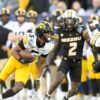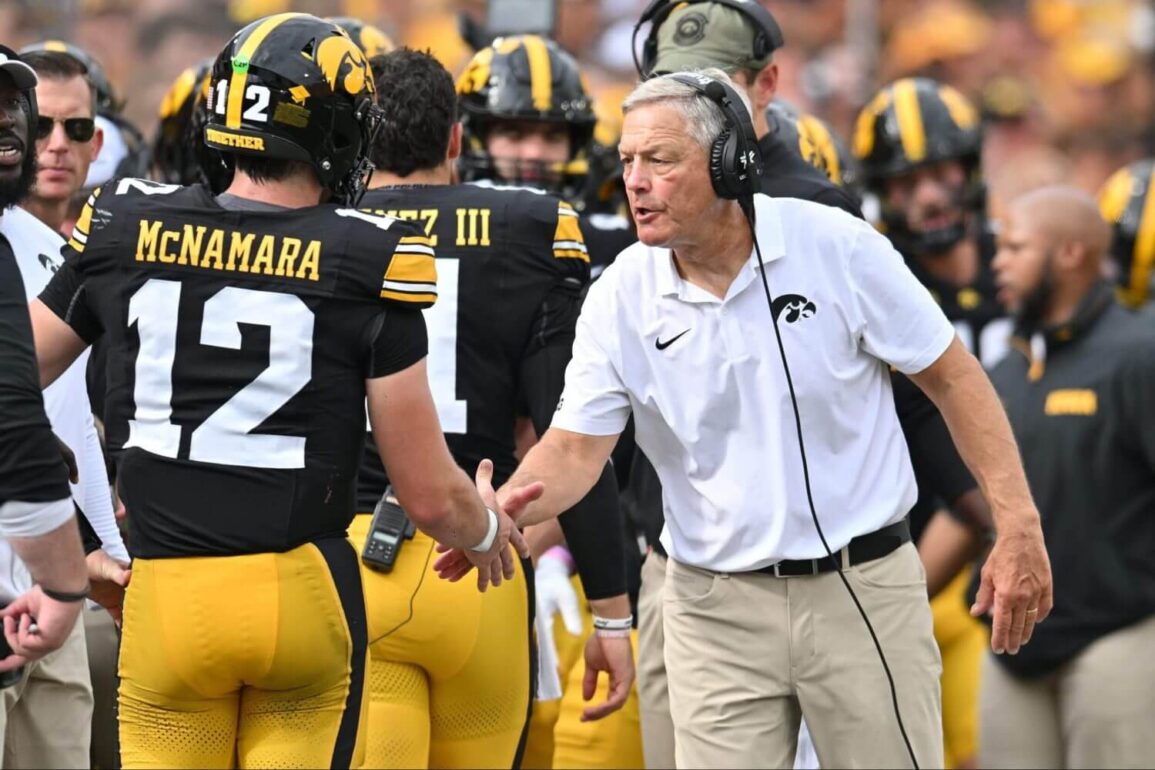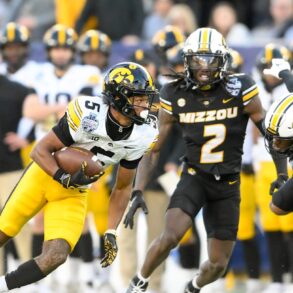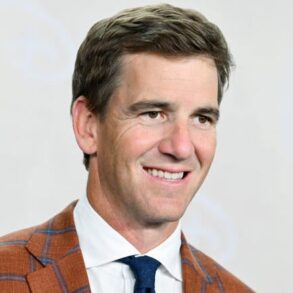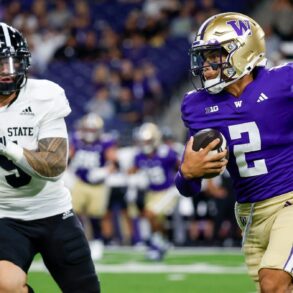IOWA CITY, Iowa — For the better part of a half-decade, backhanded compliments have branded the Iowa football program as both a winner and a loser, none phrased better than the “Punting is Winning” T-shirts once sold by former All-America punter Tory Taylor.
Taylor and his predecessors regularly blessed the Hawkeyes’ defense with great field position. In 2023, Iowa’s defense led the nation in yards per play allowed for the second consecutive season and gave up only 14.8 points per game despite playing 970 snaps, fourth most in the country. The stifling combination of those two phases over the last decade helped the program to 89 wins since 2015, which ranks 11th among power conference programs in that span.
Advertisement
However, Iowa’s offense became a roadblock on the program’s path toward contending for a Big Ten title and College Football Playoff berth. In 2023, the Hawkeyes averaged 15.4 points and a Football Bowl Subdivision-worst 234.6 yards per game, the lowest yardage output by a Big Ten program in 39 years. Iowa won 10 games that year to claim the Big Ten West Division title, but the national fascination with the “Drive for 325 (points)” as laid out in offensive coordinator Brian Ferentz’s revised contract overshadowed the team’s success.
With the Big Ten expanding by four schools and scrapping divisions, the Hawkeyes needed to change on offense or they would fall further in the league hierarchy. Their first big move came last year, when head coach Kirk Ferentz hired Tim Lester to replace Brian Ferentz as offensive coordinator. The second took place in January, when the Hawkeyes landed FCS All-American quarterback Mark Gronowski in the transfer portal from South Dakota State.
Together, Lester and Gronowski are tasked with erasing a narrative, flipping Iowa’s offensive trajectory from punchline to punchy. This spring, the unit bore no resemblance to the 2023 group that attracted so much ridicule: Receivers got open with consistency, offensive linemen created holes for running backs to hit. And once Gronowski fully recovers from offseason shoulder surgery — he’s full-go beginning with June workouts — the Hawkeyes could turn their program’s biggest flaw into a potential strength.
“I’ve been hearing that a lot, that usually the defense has dominated practices and stuff,” wide receiver Jacob Gill said. “We’ve taken a different approach to it. We go out there with a chip on our shoulder that we’re here to dominate.”
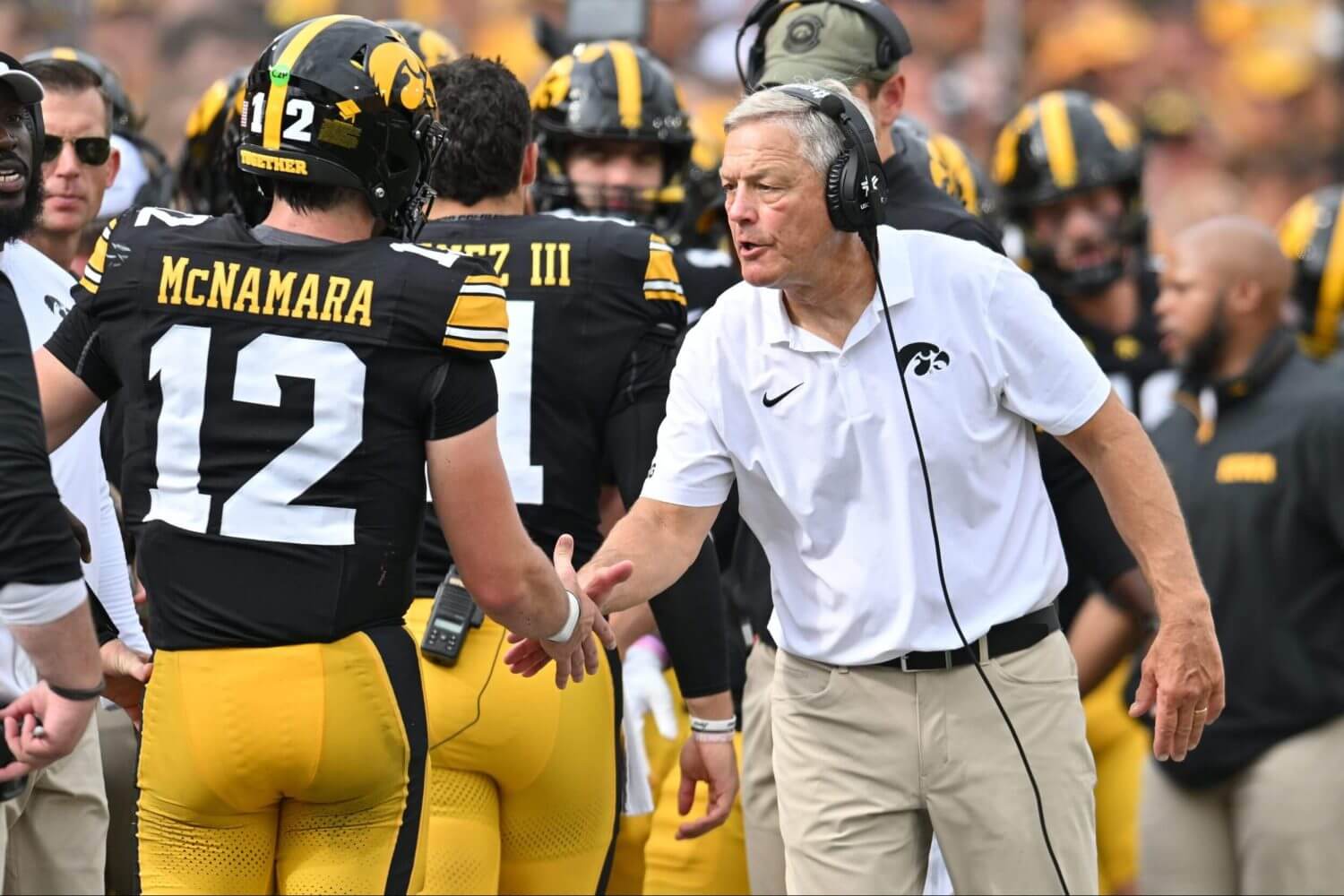
Head coach Kirk Ferentz has won despite a string of quarterbacks who have not met expectations. (Jeffrey Becker / Imagn Images)
The 2023 FCS player of the year and a two-time national champion, Gronowski threw for 10,309 yards and accounted for 131 touchdowns over four seasons with the Jackrabbits. His addition could finally answer the question asked repeatedly of Iowa during the 2022 and 2023 seasons: “How good would this team be if it had a decent quarterback?”
Advertisement
“If your quarterback play is good, that makes things a little bit easier,” Kirk Ferentz said. “It’s been a challenge for us. I think everybody knows that.”
Quarterbacks like Gronowski don’t come cheap through the transfer portal, but if he can win games on his own, it’s a bargain for the Hawkeyes. Every freshman quarterback Iowa has recruited since 2017 left the program with eligibility remaining. Four other transfer quarterbacks also exited with years to spare. Only one quarterback remains on the roster from last season, and that’s walk-on Jackson Stratton, who began the year as a fifth-teamer only to start two games after injuries took out four other quarterbacks.
Over the last four seasons, Iowa quarterbacks have combined for 38 touchdown passes and 37 interceptions. Not since third-round NFL Draft pick C.J. Beathard guided the Hawkeyes to a 12-win campaign in 2015 has a quarterback consistently elevated Iowa’s offense in critical moments. The program tried to rectify the issue two years ago when it landed Michigan transfer Cade McNamara. But injury issues ranging from a torn quad to a torn ACL and a concussion, coupled with inconsistent play when McNamara was healthy enough to go, rendered the signing a net negative on the field.
For 2025, Iowa first pursued former Penn State quarterback Beau Pribula, who ultimately chose Missouri. After South Dakota State’s FCS playoff run ended in the semifinals, Gronowski considered entering the NFL Draft and was invited to the East-West Shrine Bowl, but his injury was severe enough to require surgery and put his NFL plans on hold. He entered the transfer portal and was greeted with a dizzying flood of interest from FBS teams.
“I had over 100 missed calls at one point, over 100 missed texts,” Gronowski said. “It was even crazier when my coaching staff at my last school left as well.”
Advertisement
When former South Dakota State head coach Jimmy Rogers moved to Washington State, Gronowski instantly became his target. Miami sought him, too, before landing Carson Beck for $3 million. Gronowski’s offers soared well past $2.5 million, a range typical for top-tier quarterbacks. Iowa, which plans to allocate the maximum of roughly $20.5 million in shared revenue to athletes across all sports starting July 1, had much to offer. With additional contributions from its Swarm Collective, the Hawkeyes refused to step aside in pursuing Gronowski.
“We got to see him on film, and that speaks for itself,” Ferentz said. “More importantly, I think quarterback is a leadership position. There’s no avoiding that. He clearly did that. He delivered his team to victory a lot, and that’s really impressive.”
Gronowski, who grew up three hours east of Iowa City in Chicago’s west suburbs, was equally attracted to Iowa. The Hawkeyes’ schematic changes under Lester, tough-minded culture and high-level consistency assured the quarterback he could thrive on the field and compete for a College Football Playoff berth in his final season of college eligibility. The Hawkeyes didn’t offer the highest financial number, but they were on the leaderboard.
“It’s a part of college football,” Gronowski said. “You’ve got to take advantage of it when you get the opportunity, but that wasn’t the sole decision in the process at all.”
By signing two other transfer quarterbacks in Hank Brown from Auburn and Jeremy Hecklinski from Wake Forest, plus true freshman Jimmy Sullivan and plans for two 2026 freshman quarterbacks, Iowa hopes to build stability on the field and prevent making a costly splurge at the position an annual tradition.
“It’s just like the NFL,” Iowa general manager Tyler Barnes said. “If you can draft a quarterback and get them for four years and save on that salary cap versus going to get a free agent … we got to really try and make sure we can hone in our quarterback recruiting in high school and hit on those guys. But if we have to go to the portal, we will.”
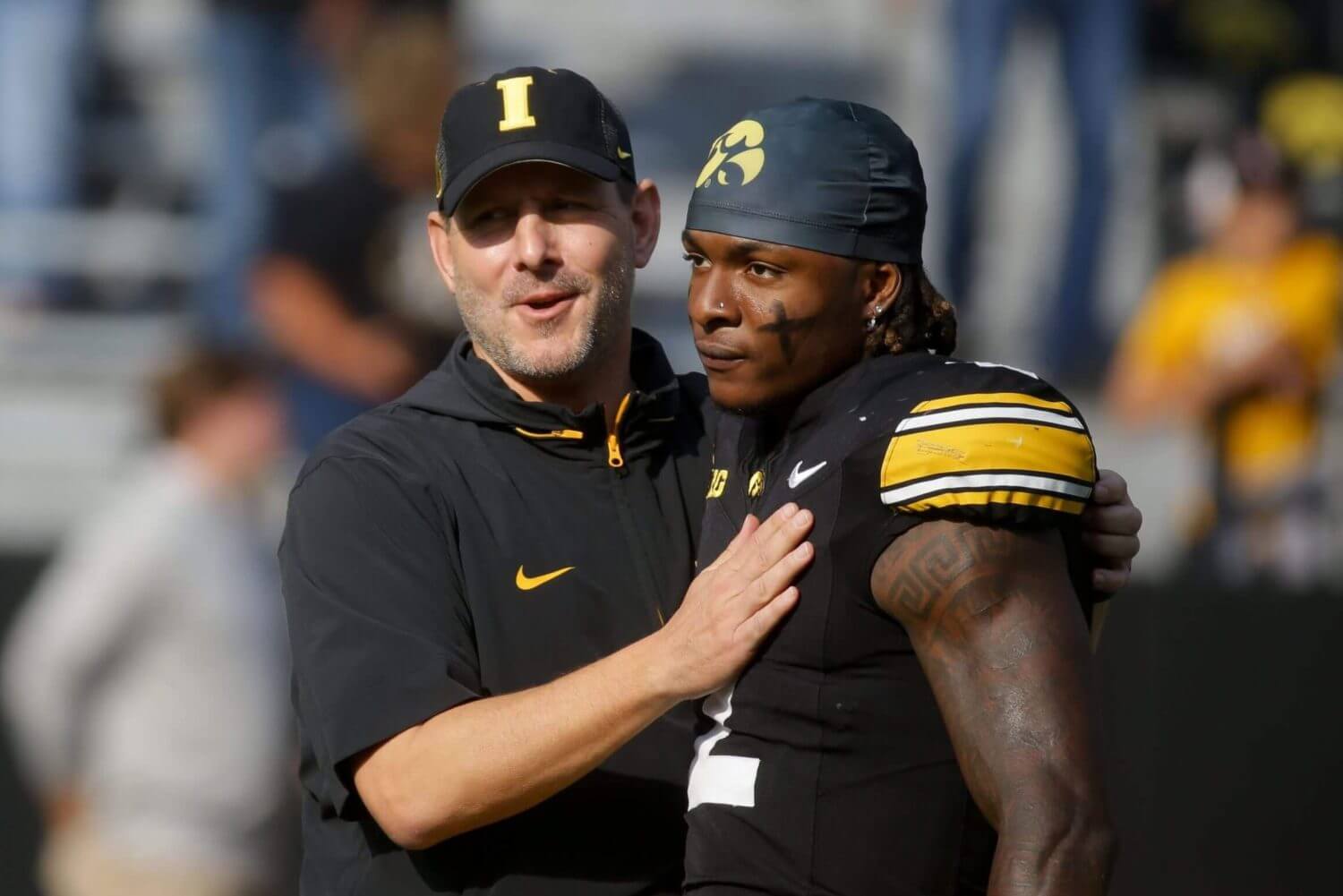
Offensive coordinator Tim Lester and running back Kaleb Johnson teamed up to get the Hawkeyes offense closer to respectability in 2024. (Julia Hansen / Iowa City Press-Citizen / USA Today Network via Imagn Images)
Gronowski’s decision was the offseason’s boldest move, but revitalizing Iowa’s offense required more than a quarterback reboot. When Lester arrived in January 2024 after a season as an analyst on Matt LaFleur’s Packers staff, he immediately installed an offense off the Mike Shanahan tree, featuring extraordinarily wordy play calls and heavy pre-snap movement.
Advertisement
The scheme still incorporates a zone running system, long a staple under Kirk Ferentz. But incorporating a mid-zone run completely changed the Hawkeyes’ ground game, enabling first-team All-American running back Kaleb Johnson to get vertical quicker. Offensive linemen tweaked their aiming points from the play-side jersey number to the screws on the defender’s helmet, which helped them reach their blocks on time. Yet the program’s blocking principles remained the same, with an attacking style rather than one designed to wall off opponents at the point of attack. Iowa’s pre-snap motion and disguised formations caused identification problems for its opponents and even its own defenders in practice. That wasn’t the case before Lester arrived.
“You don’t know where to put your eyes and you don’t know what to pay attention to,” said former Iowa linebacker Jay Higgins, a unanimous first-team All-American in 2024. “I would hate to play Iowa because you don’t know what’s coming. They could do literally anything.”
The one-dimensional 2024 Hawkeyes ranked second in the Big Ten in rushing yards per game (197.2), the program’s most since 2002, and gouged opponents for a Big Ten-best 28 runs of 20-plus yards. They put up 38 or more points five times last year, including 40-plus in consecutive home games against Washington, Northwestern and Wisconsin. This spring, Badgers defenders finished every practice with 42 pushups, a reminder of their 42-10 loss at Iowa in November.
“When have you ever heard of Iowa scoring 42 points ever? Like ever?” linebacker Darryl Peterson asked reporters. “Forty-two points is unacceptable, especially to those guys.”
Lester made it a stated goal to cut the team’s national ranking in half in most offensive statistical categories. Among last year’s dramatic improvements was a leap from 132nd out of 134 FBS teams in scoring to 72nd (27.7 points per game). Although he has avoided setting statistical team goals thus far, Lester’s benchmark for his new quarterback is more nebulous than numbers-based.
“Positive football plays,” Lester said. “Especially when you are calling it aggressively where he can bail you out of, ‘Hey, this is a bad look.’ Just check it down, get us a yard. Throw it away for all I care. Just don’t take a sack. Don’t throw a pick.”
To shore up scheme development and future game planning, Ferentz hired former Wake Forest offensive coordinator Warren Ruggiero and former New York Jets offensive coach Billy VandeMerkt as analysts. Iowa’s new running backs coach Omar Young, like VandeMerkt, coached within a Shanahan offense in the NFL. Those moves, Lester said, have been “fantastic to have other people that can speak the language.”
Advertisement
The staff feels good at running back and tight end despite losing Johnson and Luke Lachey to the NFL. The offensive line boasts potential All-Americans in center Logan Jones and right tackle Gennings Dunker. This spring, the staff determined it needed a left tackle, so the Hawkeyes beat out USC for Division II All-American Bryce George from Ferris State.
There’s optimism at receiver for the first time this decade. The unit returns all but one catch from its 2024 production. Last winter, Iowa signed Chattanooga receiver Sam Phillips, who has 154 career catches for 2,108 receiving yards at the FCS level.
“I’m trying to push this unit to be the best it’s been in a while,” said receiver Kaden Wetjen, a first-team All-American kick returner in 2024. “If we can put all the pieces together, we should be really special this fall.”
It’s not a given that Gronowski’s arrival turns Iowa into a CFP contender. The Hawkeyes host 2024 CFP teams Indiana, Penn State and Oregon and travel to Big 12 runner-up Iowa State. Plus, there are annual rivalry games with Wisconsin, Nebraska and Minnesota and trips to the East Coast (Rutgers) and the West Coast (USC). With that type of schedule, no longer could Iowa rely on just defense and special teams. Thanks to Lester’s schematic changes and Gronowski’s presence — coupled with the program’s tenets — it has more to offer. No more punting puns, no more “Drives,” but perhaps more yards and more points.
“Just talking with Lester and seeing the progression of the offense from the year prior to this last year was really cool to see,” Gronowski said. “It just made me happy about what was going to be going on and the growth that we’re going to have this offseason.”
(Top photo: Joseph Cress for the Register via Imagn Images)
This post was originally published on this site be sure to check out more of their content.



